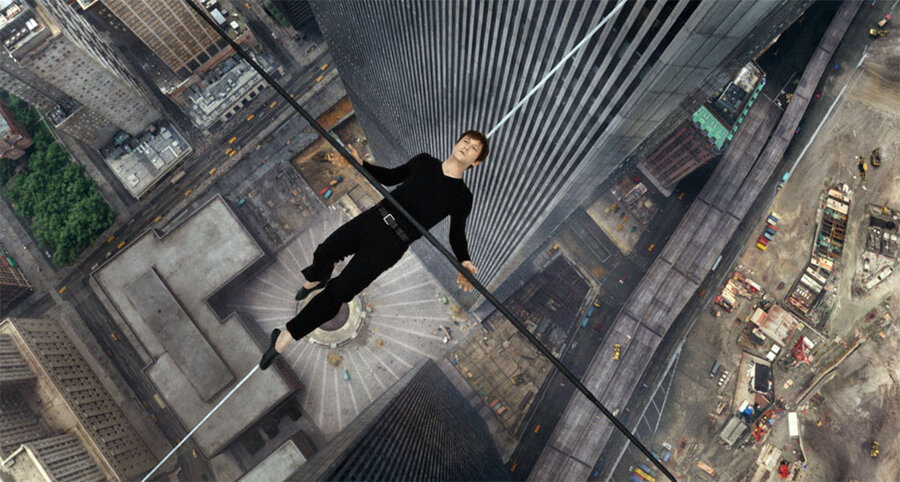'The Walk': The film does nothing to analyze Philippe Petit's psyche
Loading...
It’s a cliché that movies can transport you to places you’ve never been, and never will be, but Robert Zemeckis’s “The Walk,” at least for its final 40 minutes or so, really delivers on that premise. What comes before in the movie, however, takes you to places you’ve visited, literally and figuratively, too many times in too many mediocre movies.
The "walk" in the film’s title refers to the 1974 aerial feat where 24-year-old Philippe Petit, played in the movie by Joseph Gordon-Levitt, walked back and forth across a cable strung between the twin towers of the World Trade Center. The who, what, when, where of this particular act of bravery, or madness (take your pick), were well delineated in James Marsh’s 2008 documentary “Man on Wire” – which I saw at the Sundance Film Festival, after which Petit bounded onstage and, no joke, tripped.
By contrast, Zemeckis’s film, co-scripted by Christopher Browne from Petit’s memoir “To Reach the Clouds,” doesn’t do an especially good job of examining Petit’s monomaniacal desire to be a high-wire walker. We’re given the usual movie tropes: shots of the rapt young Philippe watching a circus act or, later on, juggling and wire-walking for spare change on the Left Bank, etc. The progression of his skills, aided by a paternal circus mentor (Ben Kingsley, in a role that embellishes the true story), is not excitingly, or even convincingly, displayed.
He seems to go from bumbler to master in record time, as he makes headlines walking the high wire between the two towers of Notre Dame. Then, moving to New York with his twinkly girlfriend (Charlotte Le Bon), and a team of accomplices, he sets his sights on the almost-completed World Trade Center. (Zemeckis downplays the 9/11 portents.) Up to this point, the film has a jaunty inauthenticity. Gordon-Levitt is a sprightly performer with a balletic grace, but he is required to narrate an undue share of his lines directly to the audience, starting at the beginning, where the camera pulls back to reveal him perched atop the Statue of Liberty, no less. Even worse, his accent makes him sound like Pepé Le Pew.
The high-octane narcissism that would propel Petit literally into the stratosphere is soft-pedaled. He just seems like a harmless obsessive. More than that, the film buys into the line that he is an “artist.” But there is no attempt here to separate out the performance art from flat-out lunacy. If Petit had failed in his attempt to walk the wire across the twin towers, and perhaps killed accomplices or pedestrians along with him, all this talk of artistry might have had a distinctly different cast.
But of course, as the world knows, he did succeed and even got off without doing jail time. The walk itself is the film’s central, and only, real achievement, but it’s a doozy. Zemeckis puts us right up there with Petit as he stealthily, methodically makes his way back and forth across the wire, strung 100 stories high. We are even afforded dubious multiple opportunities to look down at the city from Petit’s perch, a luxury Petit himself for the most part avoided.
Despite its nail-biting aspects, there is an almost becalmed atmosphere to this sequence. (The attendees at my screening who reportedly ducked into the rest rooms during the more vertiginous moments may disagree.) Like Petit, you never want it to end. You want to remain with him suspended in midair. This dreamlike feeling could only be achieved, I think, because we know it all came out all right.
I wish the film had done more – anything – to analyze Petit’s psyche. But he barely exists in the movie except as a certified daredevil. When, in a quick blip of a scene, he breaks up with his supportive girlfriend at the end, it comes out of nowhere and just points up the fact that we really know nothing about this guy except that, as one cop says, he’s “got guts.”
The film left me with a tantalizingly unanswered question: If Petit could only achieve bliss through acts of almost unimaginable daring, what must life be like for him now? It would have been far less “cinematic,” but a movie about the transition of Petit into senior citizenship would have been a doozy, too. Grade: B- (Rated PG for thematic elements involving perilous situations, and for some nudity, language, brief drug references and smoking.)







